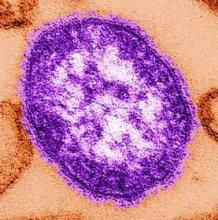The number of cases of measles reported in the United States last year was higher than any year since 1996 – an increase the Centers for Disease Control and Prevention attributes primarily to an increase in the importation of the disease from other countries and the vulnerability of susceptible, unimmunized people in the community.
A total of 222 measles cases and 17 measles outbreaks from 31 states were reported to the CDC in 2011, compared with a median of 60 cases and 4 outbreaks reported annually during 2001-2010, Dr. Anne Schuchat, director of the National Center for Immunization and Respiratory Disease’s Office of Infectious Diseases reported in a telebriefing April 19. Of the 222 cases, 200 (90%) were associated with importations from other countries, including 52 (26%) cases in U.S. residents who had recently traveled abroad and 20 (10%) in foreign visitors, she said, presenting data from the April 20 Morbidity and Mortality Weekly Report (MMWR Morb. Mortal. Wkly. Rep. 2012;61:253-7).
Of the patients who contracted the disease in 2011, 86% were either unvaccinated or had unknown vaccination status, underscoring the ongoing risk for measles among unvaccinated individuals and the importance of vaccination, despite the fact that the disease was declared to be eliminated – defined as the interruption of year-round endemic transmission – in the United States in 2000, Dr. Schuchat said.
For the purposes of the CDC report, measles outbreaks were defined as three or more cases linked in time or place, and U.S residents were classified as eligible or ineligible for measles, mumps, and rubella (MMR) vaccination according to the recommendations of the Advisory Committee on Immunization Practices, whereby vaccine-eligible patients were those who were unvaccinated or had unknown vaccination status; did not have vaccination contraindications; and were either born after 1957 and at least 12 months old without documented evidence of measles immunity or 6-11 months with a recent history of international travel, according to the report.
The median age of the infected patients was 14 years (3 months to 84 years). Of the 222, 196 were U.S. residents; of those, 166 were unvaccinated or had unknown vaccination status, 141 of whom were eligible for vaccination, 18 who were too young for vaccination, 6 who were born before 1957 and thus had presumptive immunity, and 1 with previous evidence of presumptive immunity.
Nine of the 141 unvaccinated, but vaccination-eligible patients were infants 6 to 11 months old with recent history of international travel; 14 were 12-15 months, the recommended age of the first MMR vaccine dose; and 66 were aged 16 months to 19 years, 50 of whom had not been vaccinated because of a philosophic, religious, or personal objection.
In all, 72 of the 200 importation-associated measles cases were imported from other countries, 67 were linked epidemiologically to importations, 39 had virologic evidence that suggested recent importation, and 22 were linked to cases with virologic evidence of recent importation, according to the report. Importantly, nearly half of the 72 importations occurred among individuals who contracted the disease in the European region, Dr. Schuchat said. "We don’t usually think of Europe being associated with measles, but in reality there has been a lot of measles in that region. In 2011, more than 30,000 cases were recorded in Europe, including 8 measles-related deaths. The hardest hit regions were places Americans tend to travel to, including France, Italy, and Spain."
Unvaccinated U.S. residents traveling to regions where measles are endemic put themselves and others in their communities at risk for measles and its complications, she said.
Physicians need to keep measles in mind when they encounter persons with a fever and rash, along with symptoms such as cough, coryza, or conjunctivitis, especially in persons who recently have traveled abroad or have had contact with travelers.
Despite the relatively small number of measles cases in the United States, vigilance on behalf of the public and health care providers is critical to avoid a drop in MMR vaccination coverage, which increases the risk for large, sustained measles outbreaks, according to Dr. Schuchat.
Such vigilance includes rapid public health response and high two-dose MMR vaccine coverage, she said, noting that one dose of the vaccine is recommended for all children ages 12-15 months and a second dose at 4-6 years. Further, adults without evidence of immunity should receive one vaccine dose, and unvaccinated health care personnel, international travelers, and college students should receive two doses, according to the report.


